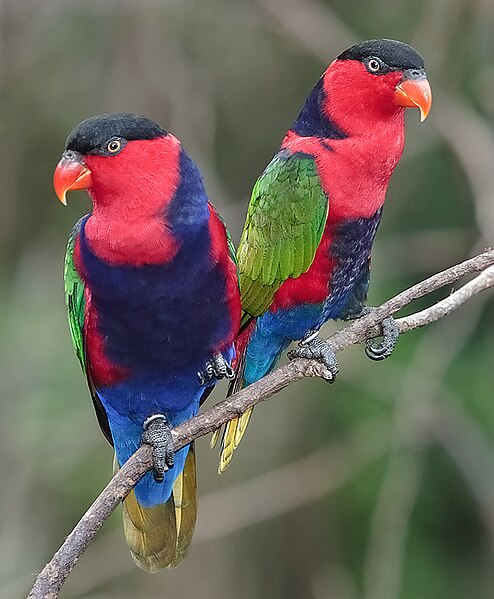Lories (parrot subfamily Lorinae) have long attracted aviculturists, yet there are many factors that weigh against their choice as pets. Noisy and aggressive towards other birds, all species feed on nectar and fruit, which, along with watery feces, they fling about their cages…keeping their living quarters clean is quite a chore.
Why then do so many people continue to put great efforts into their care? Simply put, they are the most gorgeously colored and acrobatic of all birds, and quickly become affectionate, playful companions. Fortunately, the availability of specially formulated lory food has greatly simplified their care.
Red or Moluccan Lory, Eos bornea bornea
 This was the first lory I worked with, back as a boy helping out in a pet store (I say “helping out” because I was not paid, other than by being allowed to take sick animals home!). Without any real training, our red lory climbed down from his store-front perch each evening and walked to the back of the shop and into his cage. As soon as we began to close up for the night, off he went!
This was the first lory I worked with, back as a boy helping out in a pet store (I say “helping out” because I was not paid, other than by being allowed to take sick animals home!). Without any real training, our red lory climbed down from his store-front perch each evening and walked to the back of the shop and into his cage. As soon as we began to close up for the night, off he went!
This responsiveness, along with “screaming” scarlet plumage, has rendered the red lory quite popular with parrot enthusiasts. It reaches 12 inches in length, and breeds fairly well, especially if exposed to temperatures of 90-93 F for a time. Like all their relatives, red lories do best in outdoor aviaries or large cages.
Red lories are limited in distribution to Saparura and Amboina Islands, west of New Guinea. They favor mangrove forests, but will feed in parks and farms if dense tree cover is available nearby. Relatives that also appear in the pet trade include the blue-streaked and black-winged lories.
Black-Capped Lory, Lorius lory lory
 A quiet (for a parrot!) voice, hardy constitution and friendly nature suit this 12 inch lory well to captivity. Its plumage is better seen than described – the black crown contrasting spectacularly with the blue body and green wings.
A quiet (for a parrot!) voice, hardy constitution and friendly nature suit this 12 inch lory well to captivity. Its plumage is better seen than described – the black crown contrasting spectacularly with the blue body and green wings.
Black-capped lories do best in an outdoor aviary at temperatures above 50 F. They tame readily, but will attack and kill other birds, including parrots much larger than themselves. Pairs sleep in a nesting box even when not breeding.
Black-capped lories inhabit Vogelkop, Batanta and nearby Papuan islands that lie northwest of New Guinea. The closely related chattering and purple-napped lories are also bred in captivity.
Tahitian Blue Lory, Vini peruviana
Despite having been bred in captivity since 1936, this tiny (6-7 inch) indigo and white lory is still found only in a few private collections and zoos. It is likely gone from its native Tahiti, courtesy of introduced rats, and now dwells only on the neighboring Cook and Society Islands.
In the mid 1970’s, a small group of confiscated Tahitian lories found their way into the Bronx Zoo and came under my care. Despite being well-bonded, the pair I kept quarreled frequently, but teamed up to harass the much larger Palawan peacock pheasants that shared their exhibit whenever the mood struck them.
Tahitians have smaller bills than most lories, and specialize on nectar and soft fruits. Mine did well on a “shake” of yogurt, honey, hummingbird nectar, papaya and blueberries, along with other fruits and insects. Like all lories, they squeeze insects to extract their softer parts, and discard the hard exoskeletons.
Further Reading
To read more about lory husbandry and natural history, please see my articles Aggression in Lories and Lorikeets and Lories and Lorikeets.
Red Lory image referenced from Wikipedia and originally posted by Stephen.
Black Capped Lory image referenced from Wikipedia and originally posted by Doug Janson.
 That Bird Blog – Bird Care and History for Pet Birds
That Bird Blog – Bird Care and History for Pet Birds


